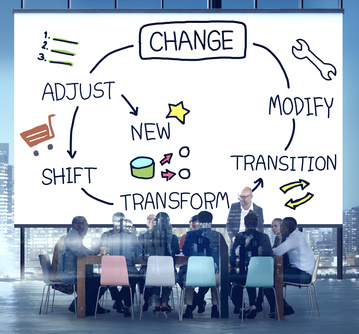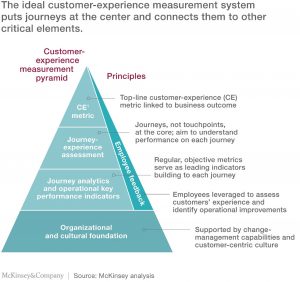Customer Experience (CX) Part 3 – Transform Your Firm with Superior Client Experience
 [Note: This post is co-authored by RainMaking Oasis and Jonathan Hollenberg of HawkPartners, a marketing strategy and research firm for Fortune 500 companies.]
[Note: This post is co-authored by RainMaking Oasis and Jonathan Hollenberg of HawkPartners, a marketing strategy and research firm for Fortune 500 companies.]
In our prior two posts Customer Experience (CX) Part 1 – Is It Different than Customer Service and Customer Experience (CX) Part 2 – Mapping the Client Journey, we discussed the difference between customer experience and customer service and how to conduct effective journey mapping to help your firm understand how clients experience and ultimately feel about your firm. This article explores the components involved in better managing the journey your clients have with the firm so that you consistently deliver the level of experience that converts them to being net promoters of your firm.
There are five key steps that firms embrace in order to connect the mapping of the customer experience to embedding positive changes into current processes and actions. Importantly, as detailed in the fifth step, once firms have new approaches in place, they need to restart the process all over again in order to become organizations that continuously strive to assess and enhance the customer experience.

Step 1: Organize
Many firms will establish a cross-functional leadership team that drives the overall client experience initiative. Some firms now have an executive devoted to Client Service or a Chief Client Officer. It may be time to follow many in the corporate world who have Chief Customer Experience Officers, or at the very least, build these responsibilities into the Chief Client (Service) Officer’s job description.
Step 2: Educate
Having mapped out the customer journey (as covered in our prior post), there may be a number of broad strategic themes that are either emblematic of the experience your clients are having or representative of the type of experience that you wish clients to have. The Leadership Team will need to think about how it can link these themes to a vision of what the firm would aspire to in its delivery of the optimal client experience, as well as its expectations for the roles of everyone in the firm in contributing to an optimized customer experience paradigm. These themes, vision and expectations ultimately provide context for the more tactical issues and challenges that have been identified which smaller teams may wish to address. Share both the learnings from the client journey mapping and the broader thematic issues with the entire firm. Whether this is communicated through a multi-office video conference call, a firm newsletter or a series of emails, the critical piece of this step is to instill the notion that this is an important issue to the firm and firm leadership. This, in turn, establishes the context for the steps that follow.
Step 3: Enable
Once the firm’s vision and expectations for providing a superior customer experience have been articulated, all employees should be encouraged to innovate on continuous improvement of the customer experience. Depending on the size of the firm, this may entail developing multiple channels (e.g., suggestion boxes) through which anyone, regardless of whether they are asked/appointed to a smaller team that will have some degree of responsibility, can contribute to the initiative. Ultimately, however, you will want to have smaller dedicated teams tasked with and engaged in identifying challenges and solutions, as well as driving activation—the act of bringing the changes to life through implementation.
To facilitate this process, you may wish to provide certain tools, worksheets, templates, approaches, processes and timelines to support smaller teams as they further interpret and assess the customer journey and generate ideas for driving change into various facets of the business that will impact the client experience. Have these teams determine which aspects of the journey are most important, i.e., create the most impact overall (either negatively or positively) and analyze the steps that lead to that experience with a focus on specific pain points. Encourage them to brainstorm ideas and process innovations. As they are developing initiatives, implore them to focus beyond the immediate challenge and consider steps and other mechanisms for how to build continuous improvement into future modifications to the process.
You may want them to map their ideas along three different sets of coordinates in order to prioritize the initiatives that are most worthy of pursuing:
- How easy or hard would it be to implement the change?
- How big or small is the likely impact of the change?
- How significant are the resources or people needed in order to ensure success of the change?
Another consideration for this enablement step is to recognize that most steps in the client experience are not solely influenced by one particular area or function of the firm. Great client experiences require coordination across functions. Once the smaller teams have met to prioritize the initiatives they would recommend pursuing, you may wish to then hold a series of brainstorming sessions of cross-functional teams together to further shape the approach the firm will take towards improvements that will shape impressions and increase client satisfaction. Customer experience is only improved when all those involved engage in ways to improve the experience and take ownership of executing on these new processes and approaches. This is not accomplished through top-down directives.
Step 4: Implement
One of the most difficult but undoubtedly most valuable step in any process is the one that involves putting plans into action. It’s one thing to say it and another to do it. The following are a few best practices to consider when activating and integrating customer experience initiatives into the fabric of your firm:
- Execution – The findings and recommendations that emerge as a result of steps 1-3 must be converted into action plans with completion dates and an assigned person responsible for overseeing implementation.
- Coordination – As suggested earlier, often the best initiatives are cross-functional in nature and require some element of sequential coordination to get off the ground. Map out the steps in advance of cross-functional initiatives such that all functions understand the timeline of items that will need to be acted on in order for the initiative to be launched in full.
- Accountability – While this is often the responsibility of the cross-functional leadership team that sits atop the entire client experience effort, pushing down ownership and accountability to the teams that are executing the initiative helps to set expectations and keeps the process moving forward.
- Sharing – As initiative implementation unfolds, teams will learn more about what works and what does not. In the best cases, individual teams share their experiences broadly such that the learning is embraced and subsequent efforts avoid the pitfalls that beset an earlier effort. This often is accomplished through regularly scheduled meetings, reports and emails.
- Monitoring – The cross-functional leadership team may wish to monitor and report on progress. This can be incorporated into the periodic meetings mentioned previously and through project timelines and status reporting software. This can be used not only to update firm leadership, but also to provide encouragement and a forum for sharing best practices across the entire implementation effort.
Step 5: Embed, Measure and Refresh
Once the plans and initiatives have been rolled out and activated, there must be a system in place to evaluate effectiveness and modify. This aspect of the program will require the following:
- Empower and hold accountable. CX attributes and actions should be built into all lawyer and employee performance evaluations and measured according to the key elements of the customer journey that your journey mapping has identified as critical touch points.
 Devise metrics, measurement schedules and reports. Customer experience must be continuously assessed to ensure that the critical touchpoints that impact the way clients feel about the firm remain positive or improve depending upon how clients’ journeys were mapped. McKinsey introduced a Customer Experience Measurement System that could be used as a framework for law firms.
Devise metrics, measurement schedules and reports. Customer experience must be continuously assessed to ensure that the critical touchpoints that impact the way clients feel about the firm remain positive or improve depending upon how clients’ journeys were mapped. McKinsey introduced a Customer Experience Measurement System that could be used as a framework for law firms.- Institute formal and ongoing feedback – These mechanisms must include both internal and external input and likely will include several of the following tools and approaches:
- Internal surveys and focus groups – cross-functional, functional – initial versus ongoing; real time feedback
- External client interviews
- Client surveys/end-of-matter surveys
- Customer journey touchpoints/pain point assessments
- Net Promoter Score
- Reinforce the vision and values – Being a firm that delivers a superior customer experience requires firms to embed this into the culture through everything it does. This is done through training and development of all employees, measurement of performance against expectations, and many different ways of recognizing and rewarding those who innovate and deliver superior performance that ultimately delivers an end-to-end outstanding customer experience that has an emotional impact on how clients view and experience your firm.

